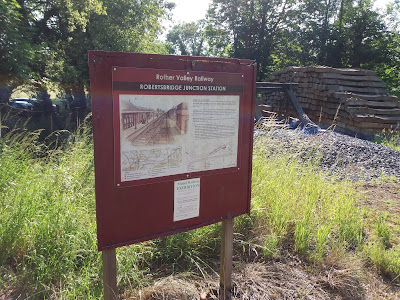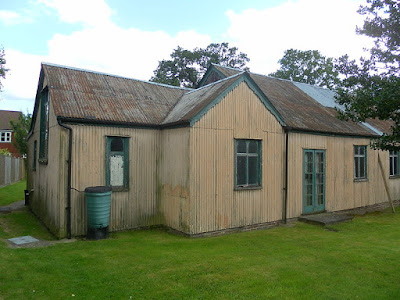After a break of over a year, I caught up with my old
walking companion Eric yesterday. We carried on where we had left off, back in
February 2016, by once again taking the train down to Robertsbridge in East
Sussex.
On this occasion we decided to cast our net slightly further
afield and walk out to the tiny settlement of Salehurst for a drink at the
quaintly named Salehurst Halt pub. I say quaintly named, but in reality there
really was a “halt” nearby, back in the days when the original Kent and East
Sussex Railway ran along the valley of the river Rother, from Robertsbridge in Sussex,
north to Headcorn in the Kentish Weald.
 We had both heard of the Salehurst Halt, and on our previous
excursion to Robertsbridge it was recommended that we should visit the pub, by
one of the locals we met in the Ostrich (the pub nearest the station). This
character assured us that the walk to Salehurst was just under 30 minutes, but
because it was dark, and we were quite comfortable in the Ostrich, we decided
to stay put and leave this walk for another day.
We had both heard of the Salehurst Halt, and on our previous
excursion to Robertsbridge it was recommended that we should visit the pub, by
one of the locals we met in the Ostrich (the pub nearest the station). This
character assured us that the walk to Salehurst was just under 30 minutes, but
because it was dark, and we were quite comfortable in the Ostrich, we decided
to stay put and leave this walk for another day.
We had also both seen the Salehurst Halt featured on an
episode of “Country File”, when singer and actor David Essex paid the pub a
visit, because it reminded him of childhood holidays, hop-picking with his East-London
family. With the weather set fair, and the summer solstice fast approaching, a
Saturday evening in mid-June seemed the ideal to make our own way to this
isolated little pub. We consequently caught the 15:59
train from Tonbridge, and 35 minutes later were alighting at Robertsbridge.
Before walking up into the village, we decided to call in at
the Ostrich for a “quick one”. The
mercury was still in the upper twenties, so a cool, refreshing pint of beer
seemed a good idea. We would also be able to check out the food option at the Ostrich,
for later on. The Harvey’s was
indeed good, but we stuck to our intention of just having the one, and then
headed off on our quest to visit Salehurst.
 We headed off up Station Street, passing the site which is
being developed to form the western terminus of the Kent & East Sussex
Railway, (more about that later). We then turned left at the “T”-junction and
made our way along the High Street with its attractive old buildings, and down the hill, passing the still sadly closed Seven
Stars pub, (more about this too, later on). We crossed the River Rother, along with
its various channels, passing the cricket ground on our left, before reaching
the junction with the busy A21 trunk road. Fortunately there is a
light-controlled pedestrian crossing, and before long the houses started to
peter out, and we found ourselves in open countryside.
We headed off up Station Street, passing the site which is
being developed to form the western terminus of the Kent & East Sussex
Railway, (more about that later). We then turned left at the “T”-junction and
made our way along the High Street with its attractive old buildings, and down the hill, passing the still sadly closed Seven
Stars pub, (more about this too, later on). We crossed the River Rother, along with
its various channels, passing the cricket ground on our left, before reaching
the junction with the busy A21 trunk road. Fortunately there is a
light-controlled pedestrian crossing, and before long the houses started to
peter out, and we found ourselves in open countryside.  We continued in an
easterly direction, along Church Lane,
and with the imposing church tower acting as our guide, we reached the tiny village
of Salehurst, and our destination
the Salehurst Halt. The pub is an unassuming brick-built, part tile-hung
Victorian building, just down from the church, and with the doors left open to
allow as much cooling air as possible to blow through, we stepped inside.
We continued in an
easterly direction, along Church Lane,
and with the imposing church tower acting as our guide, we reached the tiny village
of Salehurst, and our destination
the Salehurst Halt. The pub is an unassuming brick-built, part tile-hung
Victorian building, just down from the church, and with the doors left open to
allow as much cooling air as possible to blow through, we stepped inside.
It took our eyes a short while to adjust to the cool dark interior,
but what we found was an open plan area, grouped around the bar. There was a
choice of three cask ales waiting for us; Harvey’s
(of course), plus Dark Star American Pale and Old Dairy Summer Top. I opted for
the latter to start with, switching later to the Dark Star. Eric stuck with the
Dark Star.
 Both beers were nicely chilled, and we know that the pub has
a cellar, because we saw the landlord disappear down the hatch to change a
cask. There was a 50th Birthday Party planned for one of the regulars later on,
and whilst we were sitting at the bar the band arrived and began setting up.
Both beers were nicely chilled, and we know that the pub has
a cellar, because we saw the landlord disappear down the hatch to change a
cask. There was a 50th Birthday Party planned for one of the regulars later on,
and whilst we were sitting at the bar the band arrived and began setting up.
We decided to take a look outside with our second pint, as
there is an attractive terraced garden behind the pub, with views out across
the Rother Valley.
Given the people arriving for the party, we noticed that the few unoccupied
tables had “reserved” signs on them, so we found ourselves a space at the front
of the pub, and sat there enjoying our drinks and watching the world go by.
Salehurst seems a very pleasant little village, although my
friend, rather unfairly described it as “full of yuppies”. I pointed out that
in the 21st Century, did he really expect it to be full of rustic
farm labourers and sons of the soil, tired from a day’s toiling out in the
fields? He came back down to reality, and agreed that were it not for people
with a bit of spare money in their pockets, pubs like the Salehurst Halt would
have closed long ago.
It is fair to say that the Salehurst Halt is very much a pub
used and enjoyed, not just by the whole villager, but also other from further
afield. In recognition of this it, received the Community Pub of the Year 2016
and Consistency of Excellence awards from the local CAMRA branch. We obviously
called in at a busy time, so it would be nice to visit when it is less busy. I
imagine the pub would be equally good, after a brisk walk on a cold January day.
After finishing our second pint, we re-traced our steps back
to Robertsbridge, and to the Ostrich Hotel where we had decided to dine. The
pub was quite quiet when we arrived, so there was no problem over food. I opted
for the steak, mushroom and ale pie which, as the picture below shows, was definitely
a “proper pie”. Served with new potatoes, seasonal vegetables and a jug of
gravy, it was an absolute bargain £8.50.
Eric chose a three-egg omelette, with the aforementioned seasonal veg.
We had a couple of pints of Harvey’s
each before catching the 22.14 train back to Tonbridge. Our return visit to
Robertsbridge had been an obvious success, as not only did we renew our
acquaintance with the excellent Ostrich Hotel, but we also finally made it to
the equally good Salehurst Halt. On that subject though, we both agreed that
walking out there on a dark February evening would not have been such a good
idea; despite what the customer in the Ostrich had told us. (Incidentally, he
was there yesterday).
Footnote: I mentioned above that I would expand further on
both the Kent & East Sussex Railway and the Seven Stars, but I appear to
have run out of both space and time. I will therefore save these updates for
the next post.












































